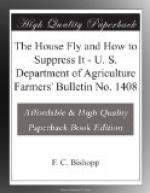In view of the possible injury from the borax treatment as a result of carelessness in applying it, or from other unforeseen conditions, it is recommended that horse manure and other farmyard manures which are to be used as fertilizer be treated with hellebore. Borax, on the other hand, is such a good larvicide that it call be used with advantage on the ground of soil-floor stables, in privies, on refuse piles, and on any accumulations of fermenting organic matter which are not to be used for fertilizing purposes.
[Footnote 11: Department Bulletin 118, U. S. Department of Agriculture, p. 25.]
TREATMENT WITH CALCIUM CYANAMID AND ACID PHOSPHATE.
Many experiments with mixtures of commercial fertilizers were tried to determine whether fly larvae would be killed by any substance the addition of which would increase the fertilizing value of the manure. A mixture of calcium cyanamid and acid phosphate was found to possess considerable larvicidal action. Several experiments showed that 1/2 pound of calcium cyanamid plus 1/2 pound of acid phosphate to each bushel of manure give an apparent larvicidal action of 98 per cent. The mixture in the form of a powder was scattered evenly over the surface and then wet down with water. The use of this mixture adds to the manure two important elements, nitrogen and phosphorus.
MAGGOT TRAP FOR DESTRUCTION OF FLY LARVAE FROM HORSE MANURE.
The second method of handling manure is one which does not require the application of chemicals. It is based on the fact, mentioned on page 4, that the larvae of the house fly, a few hours before they are ready to pupate, show a strong tendency to migrate. This migration takes place mostly at night, and the larvae sometimes crawl considerable distances from the manure pile. Now it is possible by means of a very simple arrangement called a maggot trap to destroy fully 99 per cent of all maggots breeding in a given lot of manure. A successful maggot trap which the Maryland Agricultural College constructed at the college barn is shown in Figure 9. The trap was designed by R. H. Hutchison and constructed under his supervision. The manure, instead of being thrown on the ground, is heaped carefully on a slatted platform, which stands about 1 foot high. This particular platform measures 10 by 20 feet. There are six 2 by 4 pieces running lengthwise 2 feet apart. Across these are nailed 1-inch strips with 1/2 to 1 inch spaces between them. The wooden platform stands on a concrete floor, and a rim or wall of concrete 4 inches high surrounds the floor. The floor slopes a little toward one corner from which a pipe leads to a small cistern near by. This pipe is plugged with a stopper of soft wood, and the concrete floor is filled with water to a depth of 1 inch in the shallowest part. Flies will lay their eggs on the manure as usual, but the maggots,




